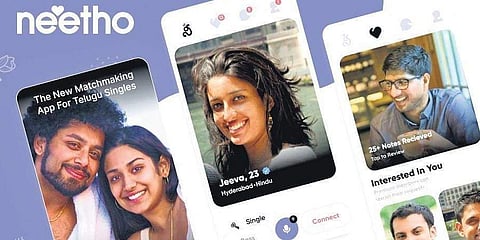
- LIFESTYLE
- FASHION
- FOOD
- ENTERTAINMENT
- EVENTS
- CULTURE
- VIDEOS
- WEB STORIES
- GALLERIES
- GADGETS
- CAR & BIKE
- SOCIETY
- TRAVEL
- NORTH EAST
- INDULGE CONNECT

Vocal for local, the slogan to encourage domestic industries, also seems to be what young Indians are chanting when it comes to dating apps. An in-house study of the Aisle dating app has found that for 70 percent of Indians, local language content is more reliable. A significant proportion of the young population in Tier II and III cities is sharing their emotions through vernacular languages. Dating apps are now cashing in on this trend.
Indian dating apps such as Aisle and QuackQuack have introduced local languages. Aisle has introduced two vernacular apps Arike and Anbe, exclusively for Malayalam and Tamil speaking users respectively residing in and out of India. “I can’t go beyond a hello and hi in English apps as I am not proficient in the language. But with the introduction of a Tamil app, I can express freely,” says Keerthi Mahalingam, a techie in Chennai, and a user of Anbe app in Tamil.
According to regional social media platform ShareChat’s 2018 Year-End Report, it was in 2018 that regional content on social media was made possible. This also aided the growth of user-generated content in native languages. Microblogging platform Twitter also localised the web user interface experience in local languages such as Kannada, Tamil, Gujarati, Bengali and Marathi in July 2019. The regional language networking and content publishing apps market was worth $1 billion by 2020, according to media reports.
With a population of over 1.3 billion, of which 20 percent is in the prime age demographic for dating, India is where dating apps want to invest in. Able Joseph, Founder and CEO, Aisle, says that of the 600 million-plus internet users in India, only a fraction is natively English/Hindi speaking. Owing to the impact of the Digital India campaign and affordable data, today there is massive growth potential to reach hundreds of millions of first-time internet users in Tier-II and III cities. “Western dating apps entered India at a time when it was considered to be a conservative market. Although the entry of western apps warmed people to online dating they didn’t fully meet the Indian dating needs as they lacked delivery to Tier-II and III users. Neetoh in Telugu is their latest offering, introduced in October in Beta version,” Joseph explains.
In a short period of time, Aisle launched Arike and Anbe, and is on the way to bring customised dating apps to all states of India, personalised to that region’s culture and habits. Arike, introduced in February, is acquiring 1000+ users daily which is 3x faster than Aisle which was launched seven years ago. Aisle recently launched two vernacular dating apps and the total member base on Aisle’s portfolio of apps is now 6.5 million, Joseph says.
He believes that there is a greater sentimental value to speaking in one’s language. “There is a ‘feel at home’ factor to speaking in the language we think. Conversing or chatting in local language breaks the ethnic barriers in romance,” says Joseph. Ravi Mittal, Founder and CEO of another dating app called QuackQuack, says the app is currently only in English primarily because their audience is pan-India and they speak many languages. However, plans are underway to add Hindi into the portfolio by January.
“Users search pan-India and the easiest and common medium to communicate is English. Having said that, we do market and advertise in languages like Hindi, Telugu, Tamil, Malayalam, Kannada, Bhojpuri, Gujarati, etc to attract users from Tier II and Tier III cities. We are exploring other regional language markets early next year," Mittal observes.
What’s the biggest advantage of regional language? Confidence? Nativity? Relatability? “Relatability makes one feel closer to understanding the product. It makes it easy to onboard users who understand the product pitch in their native language,” Mittal explains.
Raj Bhargav Jenna, an app reviewer with a channel of his own called TechToniks, observes that regional apps have become popular after top players such as Twitter, ShareChat and Koo added a local touch to the apps. It really made a difference to consumer behaviour.
“I would say that regional dating apps started picking up in March 2020 soon after the first lockdown. Many singles who were not on any of these apps before, got curious about them and started using them, perhaps due to pandemic-induced-boredom that many faced. That was also the time apps began local languages. It was the perfect coming together of demand and supply,” he says.